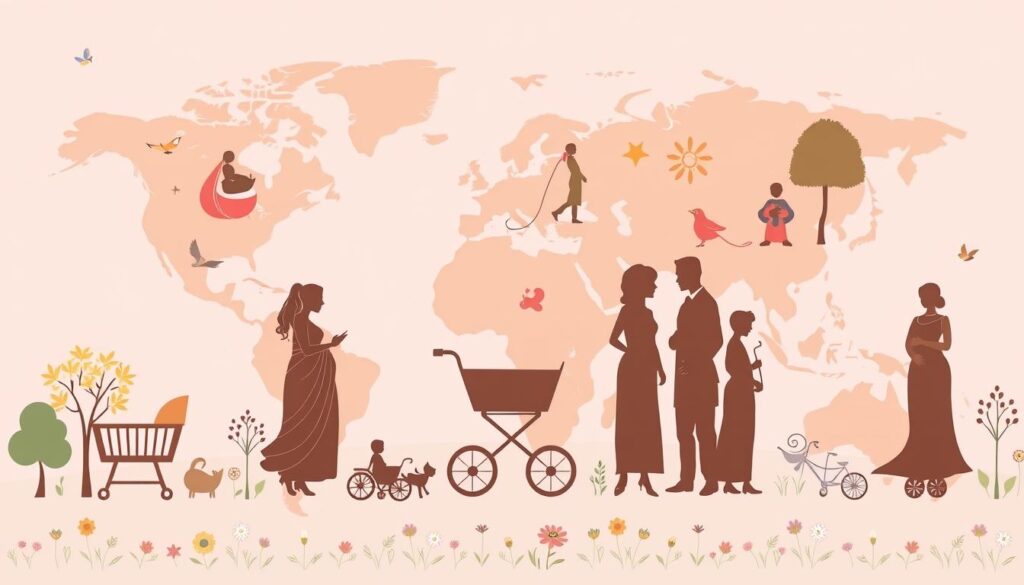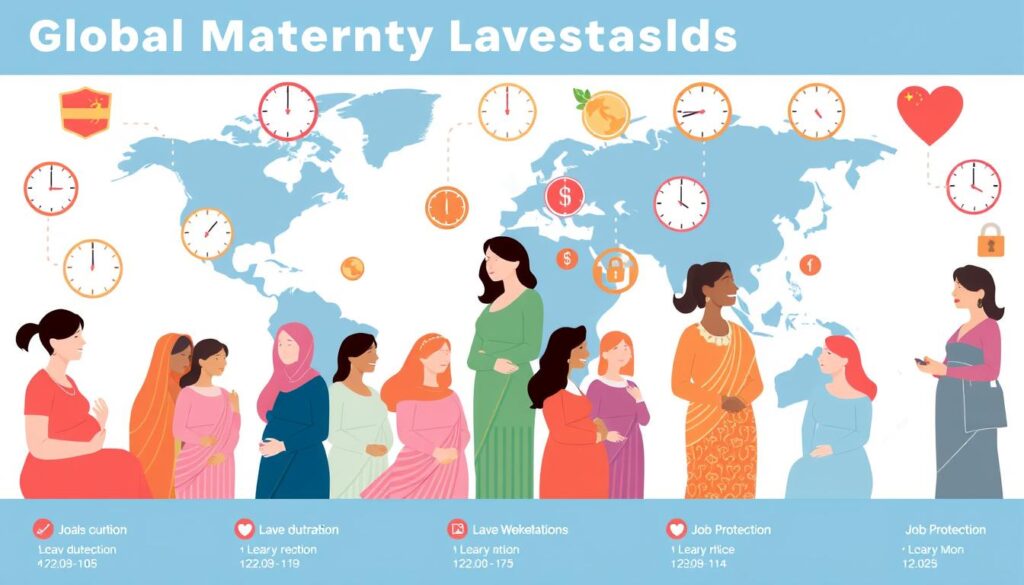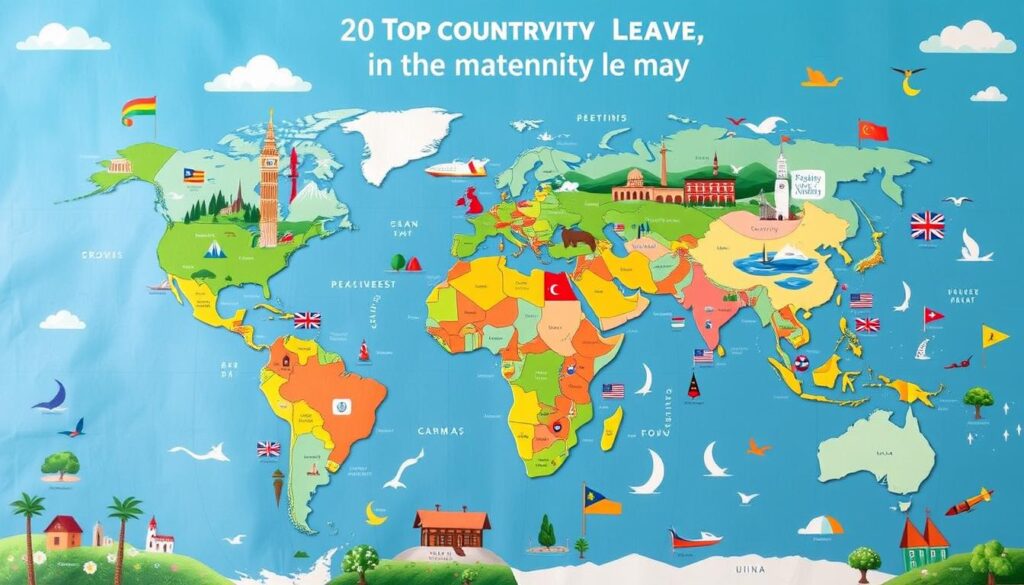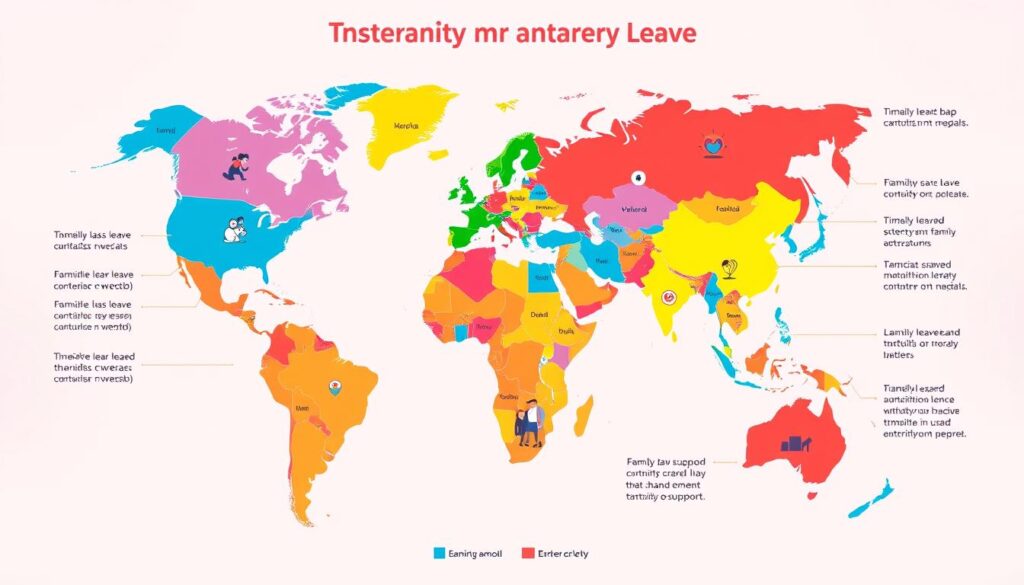Last Updated on: 30th January 2025, 03:29 pm
As we transition into 2025, the conversation surrounding maternity benefits continues to gain momentum worldwide. Understanding how various countries approach parental leave policies can be crucial for new parents navigating this significant life change. While only about 1 in 4 employees in the private sector in the US have access to paid family leave, it starkly highlights the need for improved support systems globally1. More than 3 in 4 private sector employees in the US lack such benefits, positioning the nation as a significant outlier among developed countries1. In fact, the United States stands as the only OECD country without any paid maternity, paternity, or parental leave2.
This article will explore the best countries for maternity leave, emphasizing the metrics that define effective and supportive policies for families. We will delve into how different nations prioritize maternal health and parental leave, spotlighting those that pave the way towards better maternity policies.
Key Takeaways
- The US only has about 25% access to paid family leave, showcasing significant gaps in support.
- Globally, Greece leads maternity leave with 43 weeks of leave at 61.8% payment2.
- OECD nations average around 18 weeks of paid maternity leave2.
- Countries like Norway and Sweden provide robust support with low maternal mortality ratios3.
- A notable percentage of women in the US drop out of the workforce without sufficient paid leave2.
Introduction to Maternity Leave Policies
Maternity leave policies serve as essential frameworks that guide new parents in their transition into parenthood while ensuring job security. These policies vary significantly from country to country, reflecting diverse cultural attitudes towards parenting and the importance of work-life balance. Countries like Bulgaria stand out as leaders in providing generous leave, mandating 58 weeks at 90% pay, which aligns well with international standards that recommend at least 14 weeks of maternity leave4. In contrast, the United States, which only offers 12 weeks of unpaid leave under the Family and Medical Leave Act (FMLA), has become one of the few countries globally that does not guarantee any paid maternity leave5. This disparity highlights the pressing need for improved employee rights in terms of parental leave However, many companies within the U.S., including Amazon and Facebook, have adopted their own maternity leave policies to attract talent and accommodate their employees’ needs6.
Understanding the various maternity leave policies worldwide is crucial for fostering a culture that values family and supports the well-being of both parents and children. Countries with comprehensive paid maternity leave offer numerous benefits, including better health outcomes for infants and increased workforce participation for mothers. Balancing employee rights with parental support remains a fundamental consideration for policymakers as they strive to create environments conducive to family growth and economic stability.
Understanding Maternity Leave Worldwide

The landscape of maternity leave varies significantly around the globe, with countries offering a wide range of benefits under different parental leave systems. In Northern and Eastern Europe, generous provisions stand out, with nations like Bulgaria providing an exceptional 410 days of paid maternity leave at 90% of salary7. Similarly, Sweden leads with 480 days of parental leave, ensuring both parents receive equal opportunities for bonding with their child7. This approach promotes family-friendly workplaces by encouraging shared parenting responsibilities.
Globally, 62% of countries now meet the International Labour Organization’s standards of offering women at least 14 weeks of paid maternity leave, a significant increase from 41% in 19958. Studies demonstrate that adequate maternity leave positively impacts not only families but also economies, with female employment rates linked to GDP growth8. In contrast, many regions still fall short in their maternity leave policies, resulting in considerable disparities in parental support.
Paid parental leave is known to yield long-term health benefits, such as reducing infant mortality and promoting breastfeeding in low- and middle-income countries8. Emphasizing these statistics indicates a pressing need for improved policies that cater to the health and well-being of families. For parents, understanding the differences in maternity leave systems helps shape expectations and decisions about family planning and career trajectories.
Key Factors Defining the Best Maternity Leave

When evaluating the best maternity leave policies globally, several key factors come into play. Three critical areas stand out: the duration of leave, pay rates and benefits, and job protection policies.
Duration of Leave
The duration of leave varies significantly among different countries. For example, Bulgaria leads with a remarkable 410 days of maternity leave at 90% pay, while countries like Australia offer 12 months of unpaid leave, supplemented by a Paid Parental Leave Scheme that provides 20 weeks at the national minimum wage9. Estonia provides 140 days of maternity leave, followed by 3 years of parental leave with financial support10. This variation greatly affects parents’ ability to balance work and family life.
Pay Rates and Benefits
Pay rates and benefits during maternity leave significantly impact a family’s financial stability. In France, maternity leave is fully paid based on the average income of the past three months, adhering to the social security ceiling9. Norway offers a choice between 15 weeks at full pay or 19 weeks at 80% pay, making it flexible and accommodating9. Additionally, Singapore’s arrangement mandates that the first 8 weeks are paid at the full salary by the employer, followed by government support9. These differences highlight how financial security during this period can lead to better outcomes for both parents and children.
Job Protection Policies
Job protection policies play an essential role in ensuring that parents can return to their jobs without fear of losing their positions. Countries like the United Kingdom provide up to 52 weeks of maternity leave with Statutory Maternity Pay for 39 weeks, ensuring strong legal protections for parents9. Israel offers up to 26 weeks of leave for those employed for over a year, reinforcing job security9. Effective job protection policies are crucial in helping parents navigate their return to the workplace after maternity leave.
Best Countries For Maternity Leave

The global landscape of maternity and paternity leave reveals significant differences in policies that support new parents. A closer look at the top maternity leave countries uncovers exceptional frameworks designed to facilitate parental bonding and care for newborns.
Bulgaria: Leading the Way with 410 Days
Bulgaria sets the benchmark by offering an impressive 410 days of paid maternity leave, allowing mothers to receive compensation at 90% of their salary. This generous policy not only supports the well-being of new families but also highlights Bulgaria’s commitment to promoting child welfare. The flexibility of transferring the remainder of the leave to fathers helps foster a shared responsibility in childcare, which is crucial in promoting gender equality in parenting.
Norway: Generous Policies with Flexibility
Norway stands out with its flexible approach, offering new mothers the option to take 49 weeks at full pay or 59 weeks at a reduced pay rate. This flexibility allows families to tailor their parental leave to their specific needs, ensuring the best possible start for their child. With policies that extend similar maternity leave rights to adoptive parents, Norway undoubtedly showcases its commitment to inclusive parental support.
Sweden: Equal Opportunities for Both Parents
Sweden provides a total of 480 days of parental leave split between the parents, ensuring both have the opportunity to engage in early childcare. Offering approximately 80% of their regular salary during this leave accentuates the importance of shared parenting responsibilities. This policy fosters an environment where both parents can actively partake in their child’s development during formative months. For additional insights into parental leave policies, consider exploring resources detailing the top maternity leave countries.
| Country | Maternity Leave Duration | Pay Percentage | Transferable Leave |
|---|---|---|---|
| Bulgaria | 410 days | 90% | Yes |
| Norway | 49 weeks (full pay) / 59 weeks (reduced) | Full or reduced | No |
| Sweden | 480 days | 80% | Yes (150 days) |
These comprehensive analyses of maternal policies reflect the various approaches taken by these leading nations. Such information supports ongoing discussions about improving parental leave worldwide, especially in countries like the United States, which remains laggard in offering statutory paid leave. As awareness grows about the benefits of paid parental leave, it emphasizes the importance of advocating for continued improvements in family support structures across the globe, aligning with the increasing demand for progressive parental rights111213.
Maternity Benefits and Support Services
Countries worldwide are increasingly recognizing the importance of extending support to new families through effective maternity benefits and childcare assistance programs. These benefits help ease the financial burden associated with welcoming a new child, ultimately allowing families to focus on their newborns without undue stress.
Parental Leave Policies
Parental leave policies provide additional support beyond traditional maternity leave, ensuring both parents can bond with their child. For instance, Sweden leads the way with an impressive 480 days of parental leave accessible to both parents, allowing for shared responsibilities during the early stages of childcare13. Likewise, Bulgaria offers an extensive 410 days of maternity leave at 90% of the mother’s wage, emphasizing its commitment to new parents7.
Several other countries have also embraced comprehensive parental leave policies. Norway provides new mothers with the option of 49 weeks at full pay or up to 59 weeks at an 80% pay rate7. Iceland offers a combination of four months each of maternity and paternity leave, further promoting parental involvement in early childcare13.
Childcare Assistance Programs
Childcare assistance programs play a crucial role in supporting families after maternity leave ends. Countries like Finland provide up to 164 days of total parental leave, highlighting an approach that combines both maternity and paternity leave while offering options for transferring benefits between parents13. This flexibility allows families to adapt their childcare strategies according to their evolving needs.
In addition, childcare assistance helps mitigate costs associated with early childhood care. A comprehensive understanding of these initiatives reveals the dedication of numerous nations to create a supportive environment for families. The integration of childcare assistance with maternity benefits showcases a forward-thinking approach to family well-being and development .
Comparative Analysis of Maternity Leave by Region

Examining the regional maternity leave differences reveals stark variations across the globe. For instance, Europe leads with countries like Bulgaria and Croatia providing up to 58 weeks of maternity leave14. In contrast, the United States ranks poorly, offering only 24 weeks of combined job leave for couples, significantly lower than nations like France and Spain, which often exceed 300 weeks15.
Overall, the global average for maternity leave duration is 16.3 weeks, with 78.9% of countries providing between 10 and 20 weeks16. In Asia, the situation is less favorable, with an average of 14.4 weeks16. This disparity highlights the need for consideration of employee rights globally as many countries still lack comprehensive maternity benefits.
Countries are increasingly acknowledging the importance of both maternal and paternal leave. Japan and Korea show notable improvements in paternity policies, enhancing global maternity benefits across regions. It’s essential to recognize that even though the U.S. falls behind in paid maternity leave, some states like California and New York have developed their programs to address these gaps for overall job protection15.
Postnatal Support and Maternal Health Initiatives

Postnatal support plays a crucial role in promoting maternal health and ensuring a smooth transition into parenthood. Effective healthcare access and resources, combined with robust community support systems, are vital for new mothers to navigate the challenges faced after childbirth.
Healthcare Access and Resources
Healthcare initiatives focusing on postnatal care provide essential support to mothers during early parenting stages. In the United States, the analysis of maternal mortality trends showed significant issues that need addressing through improved postpartum care17. Midwives significantly contribute to maternal health, with frameworks established to enhance the quality of care17. Research shows that around 60% to 90% of pregnancies are classified as normal or low-risk, highlighting the need for targeted support during this period17. Countries with paid maternity leave have experienced reductions in infant mortality rates, demonstrating the positive impact of such policies on maternal and child health18.
Community and Family Support Systems
Community support systems are equally important for aiding new parents. Various cultural practices enhance the transition into parenthood, creating a rich environment for maternal health. In OECD countries, 34 nations offer paid family leave to parents, emphasizing the value placed on postnatal support18. These systems, along with Medicaid coverage for pregnancy and perinatal benefits, help to foster a nurturing environment for mothers, enabling them to focus on recovery and bonding with their newborns. Initiatives that encourage community postnatal care have been shown to effect positive changes in women’s health after childbirth, showcasing the value of integrated support systems17.
Gender Equality and Employee Rights

Gender equality remains a critical aspect of workplace policies, particularly in the realm of maternity and parental leave. Countries that implement robust maternity leave policies significantly contribute to women’s workforce participation, reflecting the increased female employment rates observed globally19. When maternity leave is viewed as a standard health-and-welfare measure, it normalizes caregiving responsibilities among both genders, thereby fostering an equitable environment19. The relationship between maternity leave and employee rights is particularly relevant, as generous parental leave enables both parents to equally engage in childcare duties20.
Despite these policies, the uptake of parental leave by men is notably low. In Sweden, for example, while 45% of parental leave benefit recipients were men, they utilized only 27% of parental leave days19. This pattern suggests that while policies exist, cultural perceptions still greatly influence participation rates. Male same-sex parents face additional barriers, as they often have less access to parental leave benefits compared to their female counterparts20.
| Country | Maternity Leave (Weeks) | Paternity Leave (Weeks) | Gender Equality Index Score |
|---|---|---|---|
| Sweden | 40 | 16 | 13 |
| Finland | 43 | 12 | 12 |
| USA | 0 | 2.3 | 9 |
| France | 30+ | 25 | 12 |
| Spain | 35 | 16 | 12 |
Workplace policies that favor gender equality contribute to a balanced labor market and the reduction of social stigma surrounding parental responsibilities15. Equal parental leave entitlements for both mothers and fathers can disrupt traditional gender norms, paving the way for shared responsibilities that empower both parents. Consequently, this equitable approach to employee rights fosters a more inclusive and supportive work environment, benefiting businesses and individuals alike.
Countries Lagging Behind in Maternity Leave Benefits
Globally, a significant number of nations struggle with inadequate maternity leave policies, particularly those classified as countries without family leave policies. Among the 193 countries in the United Nations, a small handful, including the United States, Papua New Guinea, Suriname, and some South Pacific island nations, lack any national paid parental leave law21.
Additionally, while at least 50 countries now offer six months or more of paid maternity leave, many still fall short of providing essential support to new parents21.
These gaps can lead to adverse outcomes, as paid parental leave policies are known to significantly impact infant and maternal health, including lower infant mortality rates and improved cognitive development21.
In stark contrast to countries with robust maternity leave frameworks, the United States remains the only developed nation without a national paid parental leave policy. This has contributed to some of the highest rates of infant mortality and health inequalities among high-income countries21.
The existing Family and Medical Leave Act provides only 12 weeks of unpaid leave, with many parents lacking coverage, underlining the urgent need for reform21.
Internationally, nations like Austria, Hungary, and the Netherlands exemplify progressive approaches, offering 100% paid maternity leave. In contrast, the U.S., along with Marshall Islands and Micronesia, does not facilitate any paid maternity leave, revealing substantial disparities in reproductive support for families6.
Furthermore, mothers in countries such as Saudi Arabia receive just 10 weeks of paid leave, while fathers often lack adequate support, receiving merely three days21. Such inequalities create barriers for women returning to the workplace and perpetuate cycles of disadvantage21.
Conclusion
Maternity leave policies are crucial for creating healthy family environments and fostering a sense of security for new parents. As outlined in our article, various countries showcase the best maternity leave practices, with Sweden leading the way by offering generous leave durations and adequate financial support that benefits not only mothers but also infants and families as a whole. The implementation of paid maternity leave has been shown to reduce infant mortality rates and improve maternal mental health, illustrating the significant impacts of these policies2223.
However, many countries, especially the United States, lag behind in providing sufficient support, leaving millions of workers without paid leave or adequate job protection. This disparity highlights the need for reform and legislative action, including advocating for policies like the FAMILY Act, which would ensure access to paid leave for all. The future of maternity policies must address these gaps to guarantee that every family receives the support they need during crucial transition periods2324.
As we look toward the future, the need for comprehensive maternity leave policies remains imperative. Countries must continuously evaluate and enhance their systems to ensure that every parent has the opportunity to bond with their newborn, contributing to healthier families and communities. Continued advocacy for future maternity policies is essential to create a world where parental leave is a standard right, not a privilege2224.
FAQ
What are the best countries for maternity leave in 2025?
How do maternity leave policies vary globally?
What factors contribute to effective maternity leave policies?
What kind of financial support can new parents expect during maternity leave?
Why are childcare assistance programs important?
How does postnatal support impact maternal health?
What role does gender equality play in maternity leave policies?
Are there countries with inadequate maternity leave policies?
Source Links
- https://finance.yahoo.com/news/25-countries-best-maternity-paternity-105215883.html
- https://www.business.org/hr/workforce-management/paid-maternity-leave-across-the-world/
- https://www.cehurd.org/the-10-best-countries-for-maternity-care/
- https://www.oysterhr.com/library/guide-to-maternity-leave-in-countries-around-the-world
- https://www.hirewithnear.com/blog/maternity-leave-by-country-how-does-the-us-compare
- https://velocityglobal.com/resources/blog/paid-maternity-leave-by-country/
- https://vacationtracker.io/blog/countries-with-the-best-maternity-and-paternity-leave/
- https://www.context.news/socioeconomic-inclusion/how-much-does-us-lag-global-progress-on-paid-maternity-leave
- https://www.playroll.com/blog/maternity-leave-by-country-guide
- https://www.lano.io/blog/which-countries-have-the-most-generous-parental-leave-policies
- https://www.engageemployee.com/blog/revealed-the-best-and-worst-countries-for-employed-new-parents
- https://remote.com/blog/best-countries-for-maternity-and-paternity-leave
- https://mauvegroup.com/innovation-hub/blog/the-5-best-countries-for-parental-leave
- https://worldpopulationreview.com/country-rankings/maternity-leave-by-country
- https://www.lisdatacenter.org/wp-content/uploads/parent-leave-report1.pdf
- https://fmpglobal.com/resources/guides/maternity-paternity-leave-statistics-around-the-globe/
- https://www.commonwealthfund.org/publications/issue-briefs/2020/nov/maternal-mortality-maternity-care-us-compared-10-countries
- https://www.ncbi.nlm.nih.gov/pmc/articles/PMC7367791/
- https://eige.europa.eu/publications-resources/toolkits-guides/gender-equality-index-2019-report/parental-leave-policies?language_content_entity=en
- https://oecdstatistics.blog/2023/01/12/paid-parental-leave-big-differences-for-mothers-and-fathers/
- https://www.npr.org/2016/10/06/495839588/countries-around-the-world-beat-the-u-s-on-paid-parental-leave
- https://www.businessinsider.com/differences-between-sweden-and-us-on-maternity-leave-2021-12
- https://nationalpartnership.org/report/paid-leave-is-essential-for/
- https://www.linkedin.com/pulse/state-parental-paternity-leave-canada-vs-other-countries-victor-anjos

As a passionate, global-thinking Real Estate Investor I am constantly looking for the best opportunities to invest in Properties. With Aparthotel.com I am building an All-In-One Global Real Estate Platform, where people can analyse, rent or invest in properties. Additionally I help Investors with comparing the best financing options as well as give detailed Consultation on the buying process for Real Estate Investments around the world. I am looking forward to sharing my knowledge on this Website and feel free to reach out to me if you have any questions.

Comments